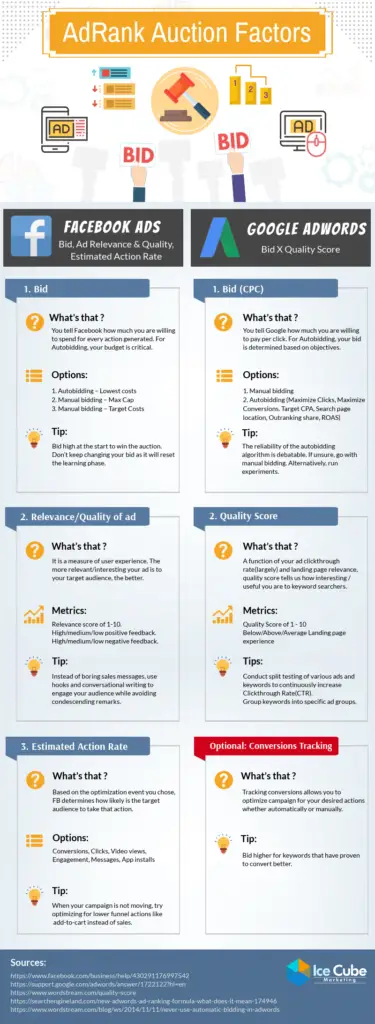Table of Contents
Google Ads and Facebook Ads, the two popular advertising platforms for digital marketers, offer powerful tools to reach your target audiences, increase brand awareness, and drive conversions. Both platforms use some auction system to place your ads.
Before you start campaigns on either or both ad auction platforms, you need to know the similarities and differences between them. two ad auctions.
Google Ads vs Facebook Ads: Similarities
Before exploring the differences, let’s examine the similarities:
1. Targeted advertising: Both platforms allow targeting specific demographics, interests, behaviors, and locations, ensuring your ads reach relevant audiences.
2. Budget control: Set budget limits to manage ad spend, and track expenses in real-time.
3. Ad formats: Offer various ad formats, including text, image, video, carousel, and story ads.
4. Performance tracking: Monitor ad performance with metrics like clicks, conversions, return on investment (ROI), and cost per acquisition (CPA).
5. Auction-based pricing: Ad pricing is determined by auction-style bidding, where advertisers compete for ad space.
Google Ads vs Facebook Ads: Differences
Now, let’s explore the key differences:
Google Ads
1. Search-based advertising: Target users actively search for products or services on Google Search, Maps, and partner sites.
2. Intent-based targeting: Reach users with specific intent, such as “buy shoes” or “book flights.”
3. Cost-per-click (CPC) model: Pay for ad clicks, with costs varying based on ad relevance and bid.
4. AdRank system: Ad position is determined by ad relevance, bid, landing page quality, and device type.
5. Google’s vast network: Reach users across Google Search, Maps, YouTube, Gmail, and partner sites.
Facebook Ads
1. Social media advertising: Target users based on interests, behaviors, demographics, and connections.
2. Interest-based targeting: Reach users with specific interests, hobbies, or affiliations.
3. Cost-per-impression (CPM) or CPC model: Pay for ad impressions or clicks, with costs varying based on ad relevance and bid.
4. Auction-based ad delivery: Ad delivery is determined by ad relevance, bid, user engagement, and device type.
5. Facebook’s vast user base: Reach over 2.7 billion monthly active users, with diverse demographics and interests.
Google Ads vs Facebook Ads: Key Considerations
When choosing between Google Ads and Facebook Ads, consider the following:
1. Business goals: Google Ads for direct conversions and sales, Facebook Ads for brand awareness, lead generation, and customer engagement.
2. Target audience: Google Ads for intent-based targeting, and Facebook Ads for interest-based targeting.
3. Ad budget: Google Ads are often more expensive due to auction-based pricing.
4. Ad creative: Facebook Ads offer more visual ad formats and storytelling options.
5. Customer journey: Google Ads for users closer to conversion, Facebook Ads for users earlier in the customer journey.
Google Ads vs Facebook Ads: Which is better?
The infographic below compares Google and Facebook ad auction ranking factors from Ice Cube Marketing.

1. Bidding
Let’s start with the bidding. Both platforms use some bidding system you have to use to place your ads.
For Facebook, the bidding is based on various actions you determine. This can be conversions, clicks, impressions, post engagement, and more. For Google Adwords, it’s on a cost-per-click basis.
Both platforms give you several options on how you want to bid. You can bid manually for the max you’d like to pay for your ad. There’s also auto-bidding on both platforms.
Facebook allows you to auto-bid for the lowest costs while Google Adwords lets you auto-bid to meet several objectives. This includes maximizing clicks, targeting a CPA cost, targeting an ad position, focusing on conversions, etc.
Facebook auto-bidding works better than Adwords if you’re on a tight budget. Auto-bidding for Adwords is usually not recommended because costs can easily go out of control.
2. Relevance and Ad Quality
Both platforms look at the relevance of your ad to determine its quality. This has an impact on how much you end up paying for your ad.
Facebook looks at how your ad matches your target audience to determine their relevance score.
Google Adwords uses something called a quality score. Quality score is determined by the CTR of your ad, the relevancy of your landing page, and the optimization of your landing page. As a result, it’s easier to test ads for various types of keywords.
For Facebook, you want to focus on hooks and conversational writing to get the attention of your target audience. This will lead to them interacting with the ad (liking, sharing, commenting) and lead to the actions you need.
For Google Adwords, you have to run many split tests for your ad, ad group, keyword, and landing pages to see the best possible results.
3. Figuring Out Your Profitability
It’s important to get a good sense of how your ad will perform and optimize it further to see better results.
Facebook uses what’s called an Estimated Action Rate. This is a figure that they use to determine the likelihood of the target audience taking your desired action (clicks, likes, video plays, etc.)
It’s best to go for easier actions (like adding to the cart) if you’re not seeing results rather than the sales conversion.
Google Adwords is all about tracking conversions. You can set a conversion goal for your campaign. Then you can optimize for this goal on either a manual or automatic basis.
Usually, the idea here is to find the sweet spot for your ad in terms of ad cost, position, and targeting. If you start to see results for specific keywords, you can try to bid higher for a better position as that may increase traffic and conversions.

Are Google Ads more effective?
Google Ads can be more effective in certain situations, leveraging their powerful targeting capabilities and ad formats:
1. Intent-based targeting: Google Ads excels at targeting users actively searching for specific products or services, capturing their immediate attention and intent.
2. Direct conversions: Google Ads drives immediate sales, leads, and conversions by targeting users with high purchase intent.
3. High-value transactions: Google Ads prove effective for expensive or high-consideration purchases, such as luxury items or B2B services.
4. Local search: Google Ads dominate local search results, helping businesses reach customers near their physical locations.
5. Competition: Google Ads are ideal for highly competitive markets, enabling businesses to outbid and outperform competitors.
However, Facebook Ads have their unique strengths:
1. Brand awareness: Facebook Ads excel at building brand recognition, leveraging visual and engaging ad formats.
2. Interest-based targeting: Facebook Ads target users based on interests, behaviors, and demographics.
3. Lead generation: Facebook Ads drive leads, sign-ups, and engagement through targeted campaigns.
4. Lower costs: Facebook Ads are often more affordable, providing a cost-effective alternative.
5. Social engagement: Facebook Ads foster social sharing, likes, and comments.
The effectiveness of Google Ads versus Facebook Ads depends on your business goals, target audience, and advertising strategy. Consider a balanced approach using both platforms.
When to Choose Google Ads
1. Direct conversions and sales: Google Ads excels at driving immediate sales, leads, and conversions, especially for e-commerce businesses, service providers, and B2B companies.
2. Targeting specific intent: Use Google Ads to target users actively searching for specific products, services, or solutions.
3. High-value transactions: Google Ads are effective for expensive or high-consideration purchases, such as luxury items, financial services, or enterprise software.
4. Search-based advertising: Leverage Google Ads for search-based advertising, dominating search engine results pages (SERPs) and reaching users with high intent.
5. Local search dominance: Google Ads helps businesses reach customers near their physical locations, ideal for brick-and-mortar stores, restaurants, and local services.
6. Competitive markets: Google Ads enables businesses to outbid and outperform competitors in highly competitive markets.
7. Measurable ROI: Google Ads provides robust tracking and analytics, ensuring measurable return on investment (ROI).
When to Choose Facebook Ads
1. Brand awareness and recognition: Facebook Ads build brand recognition, leveraging visual and engaging ad formats.
2. Interest-based targeting: Use Facebook Ads to target users based on interests, behaviors, demographics, and connections.
3. Lead generation and engagement: Facebook Ads drive leads, sign-ups, and engagement through targeted campaigns.
4. Lower-cost advertising: Facebook Ads offer cost-effective advertising options, ideal for small businesses, startups, or those with limited budgets.
5. Social media engagement: Facebook Ads foster social sharing, likes, and comments.
6. Customer nurturing: Facebook Ads help nurture customers through the sales funnel.
7. Retargeting: Facebook Ads enable retargeting ads to re-engage users who interacted with your brand.
8. Video advertising: Facebook Ads provide video advertising options.
9. Influencer marketing: Facebook Ads facilitate influencer marketing partnerships.
10. E-commerce sales: Facebook Ads drive e-commerce sales.
By considering these factors, businesses can optimize their advertising strategies.

Conclusion
Google Ads and Facebook Ads are both effective advertising platforms with unique strengths. Choose Google Ads for direct conversions, search-based advertising, and local search dominance. Opt for Facebook Ads for brand awareness, interest-based targeting, and lead generation.
Consider a hybrid approach, allocating budget to both platforms and integrating strategies. Monitor and optimize ad performance regularly. Maximize ROI by leveraging each platform’s strengths.
Test and analyze your advertising strategies to achieve success. Continuously adjust and refine your approach. By doing so, you’ll increase conversions, enhance brand awareness, and drive sales.
Ultimately, a balanced advertising strategy incorporating both Google Ads and Facebook Ads can yield optimal results.
Ted is from Ice Cube Marketing, a digital marketing agency in Singapore that helps local small businesses acquire leads from channels such as Facebook and Google.






More Stories
Chamber launches fundraiser for Blue Mountain wildfire crews: How you can help
Staying Ahead In The Dentistry Business: An Interview With Dr. Louis Bourget
If a man thinks you’re attractive but not intelligent, he’ll usually display these 9 behaviors